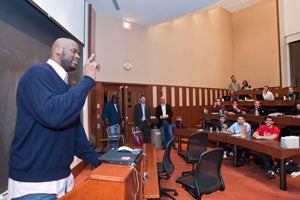Since signing with the Boston Celtics in August 2010, Shaquille O’Neal has posed as a statue in Harvard Square, sang the “Cheers” theme song at the Cheers bar in Boston, and conducted the Boston Pops at Symphony Hall. He can now add “helped teach a class at Harvard Law School” to that list.
On January 18, O’Neal visited Lecturer on Law Peter Carfagna’s course Representing the Professional Athlete. He was accompanied by Perry Rogers, his agent and President of Venture Management, and by Michael Zarren ‘04, Assistant General Manager and Associate Team Counsel for the Celtics.
The guests discussed topics including product endorsement, social media, changes in the NBA, and O’Neal’s approach to business and basketball throughout his 18-year career.
O’Neal has taken an active role in building his own brand from the early days of his career. He shared with students how, before filming his first commercial for Reebok in 1993, he rejected the original script and created a new concept on the spot, inspired in part by a movie he had seen the night before. That commercial became a cultural staple, due in part to the line that O’Neal wrote and delivered: “Don’t fake the funk on a nasty dunk.”
In fact, O’Neal’s management of his brand began well before he signed an NBA contract or any endorsement deals. When he was in high school, he created his own emblem based on his dunk style and trademarked it as the DUNKMAN, in case he ever got a shoe deal in the future.
He explained that there is no magic bullet for building a successful brand.
“Most of it is about being lucky and taking advantage of opportunities,” O’Neal said. “It was never in my plan to branch out. It was all about luck and about being as professional as possible.”
Rogers added that much of O’Neal’s success comes not only from luck and his ability to capitalize on new opportunities, but also from his ability to connect with fans. He advised the future sports agents in the classroom on how best to work with an athlete with those qualities.
“We’re blessed with a client who is really bright and really fun and really funny. As an agent, sometimes it’s just about getting out of the way,” Rogers said.
A number of professional athletes have visited Carfagna’s sports law courses in recent years, including NFL quarterback Brady Quinn and tennis player Mario Ancic. These class visits provide more than just excitement for students, because Carfagna tailors the discussion to highlight the legal principles the students have learned and works to ensure that HLS takes ownership of these celebrity appearances.
“There was lot of substance to Shaq’s visit,” said Carfagna. “As students have been negotiating and drafting endorsement and licensing agreements this semester, I believe it was immeasurably helpful for them to see the theories they’ve learned and the terms they’ve negotiated applied in practice. In that regard, visits like this truly helped me to teach the course.”
One of O’Neal’s most recent ventures is “Shaq Vs.”, a reality show in which he challenges other athletes in their own sports. The concept for the show stemmed from an argument between O’Neal and Rogers over whether he could swim one length of a pool faster than Olympic swimmer Michael Phelps could swim two lengths.
“I’m one of those guys who thinks he can do everything,” O’Neal said. “For example, if you give me the Cliffs Notes for this class, I bet I can get an ‘A’ on the test.”
The show has produced unusual contractual issues, according to Rogers. Contracts between athletes and teams generally prohibit athletes from participating in activities with a high risk of physical injury – activities such as boxing Oscar De La Hoya and racing against Dale Earnhardt Jr., both of which O’Neal has done in “Shaq Vs.” Zarren acknowledged that the show required some creative contracting.
O’Neal’s visit was well timed, coming just as students were learning about representing the mature athlete as he or she heads toward retirement. In response to Carfagna’s question about how his decisions have changed as he nears the end of his playing career, O’Neal discussed his evolving approach to basketball and how it affects his role on the Boston Celtics.
“When I first started playing basketball, I got all the blame when we lost, like a CEO. So I had to put myself in CEO mode and say, ‘If I’m going to get blamed, this is how we have to do things,’” O’Neal said.
“Now I’m in a consultant role. It would not have been advantageous for me to come here and try to take over the team at age 38 when we already have these good players. I already took care of my “me time.” I’ve been healthy and have done a lot. I have my championships. I’m retired as a CEO. Now I’m a consultant – my teammates know that if they need me, I’m right over here.”
 Rogers concluded the class with advice that, while intended for students interested in becoming sports agents, is applicable to nearly any legal field.
Rogers concluded the class with advice that, while intended for students interested in becoming sports agents, is applicable to nearly any legal field.
“My advice to you is to be likeable,” he said. “Being obnoxious is easy. Work hard to be likeable and to figure people out. Empathy is the key to every negotiation. You have to feel what they feel. If you can do that, you can get a deal done.”
“Representing the Professional Athlete” is one of a suite of courses offered by Carfagna, who has built a sports law program that now includes three course offerings; a clinical component, which placed students in a record-high 15 externships with sports teams and league offices this year; and two student-run organizations: the Committee on Sports and Entertainment Law and the Journal on Sports and Entertainment law, both of which Carfagna oversees as faculty advisor.
